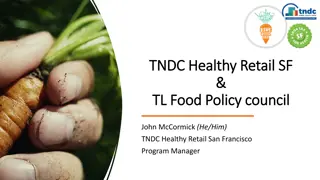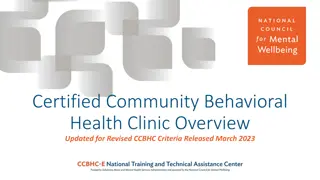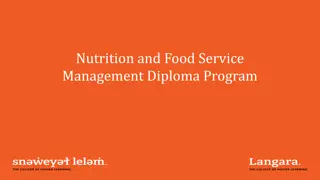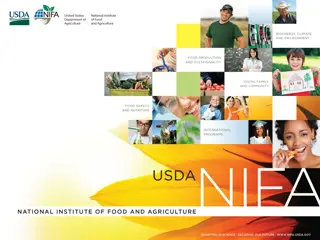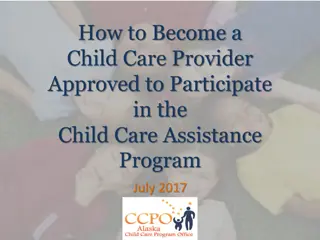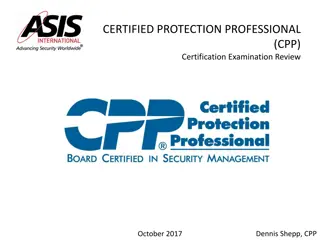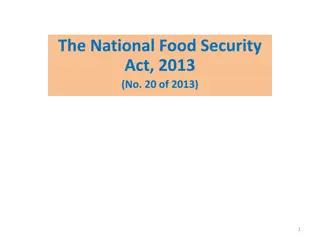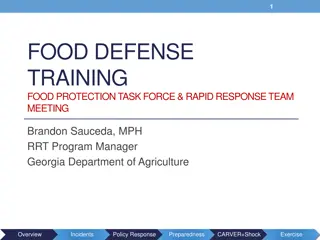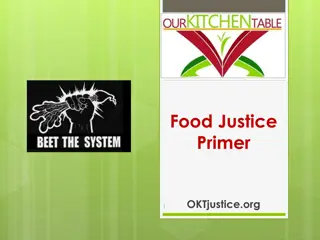Certified Food Protection Manager Training Program Overview
Discover the comprehensive course outline of a certified food protection manager training program, including real-world examples, discussions, and activities. Learn about the importance of food safety, as well as the responsibilities and reactions expected from managers in challenging situations. The module covers various aspects of food safety practices and shares experiences from professionals in the field. Dive into the world of safeguarding food and preventing potential health hazards.
Download Presentation

Please find below an Image/Link to download the presentation.
The content on the website is provided AS IS for your information and personal use only. It may not be sold, licensed, or shared on other websites without obtaining consent from the author. Download presentation by click this link. If you encounter any issues during the download, it is possible that the publisher has removed the file from their server.
E N D
Presentation Transcript
A certified food protection manager training program INTRODUCTION
Course Outline 12 Lessons and Review Exam ANSI Certified Food Safety Professional exam Satisfies North Carolina requirement for certified food protection manager
Module Basic Outline Real world examples (actual cases) Instruction Science based Prevention/Practice/Control focused Class discussion of your experience Activities Review and Questions
Sharing Experience News coverage Past work experience Behind the scenes stories Anyone who cooks or eats has seen good and bad examples of food safety. Please share your experiences with the class.
What is Food Safety? Safeguarding or protection of food from anything that could harm consumers health. This includes all the practical measures involved in keeping food safe and wholesome through all the states of production to the point of sale or consumption.
The Huffington Post, 7/17/2014 "About 40 minutes into my shift I felt nauseous. My mouth started watering, and I knew I was about to vomit. I ran into the restroom and vomited repeatedly, Elizabeth Taff told The Huffington Post. Taff says she then summoned enough strength to get through the lunch rush, hoping to track down another employee to fill in for her. But no one else was available, she said.
The Huffington Post, 7/17/2014 She noticed vomit on her work clothes and, rather than take a pay cut for a new work shirt, phoned home for someone to bring her a clean outfit, she said. She also maintains she didn't leave work for fear of getting fired and losing her paycheck. "I went and let my manager know, [but] she told me to find my own replacement after lunch rush."
The Huffington Post, 7/17/2014 "I was on my knees [on the grass outside the restaurant], while [the manager] berated me with remarks such as 'you're so stupid, if you can't handle working while feeling ill you don't need to work here, all you had to do was switch shirts and finish your shift,'" Taff told HuffPost. "She told me I was fired since I was unable to talk, due to vomiting all over the place."
Later, one of the employees took to Facebook to post a photo of Taff. The photo s caption reads: If you planned on eating at the Freeport Subway today, I'd advice you not to. I witnessed an employee vomiting and her manager telling her just to switch shirts.After calling EMS, it was discovered she had been breathing and serving food with a stomach bug that is contagious!!!!! Then they had the nerve to fire her for calling the ambulance after shaking and passing out!! Sad part she didn't call them, we did [all sic].
Think About The Case Study What are the potential negative impacts of foodborne illness? Hospitalization Fatality Law suits Legal action (business closed) Increased insurance cost Food discarded Loss of customers Loss of employment
Importance Of Food Safety Proper food safety prevents food contamination Foodborne illness sickens approximately 1 in 6 Americans every year 48 million illnesses 128,000 hospitalizations 3,000 deaths Estimated annual cost $51 77.7 billion
Your Role Person in Charge (PIC) The individual present at a food establishment who is responsible for the operation at the time of an inspection. A certified PIC should be present during all hours of operation. Active Management Control The responsibility of providing safe food for the consumer by developing and implementing food safety management systems to prevent, eliminate, or reduce the occurrence of foodborne illness risk factors. Reasonable Care Management s responsibility to take all reasonable precautions and care to avoid committing a violation of FDA Food Code.
Food Safety Culture A set of shared values that managers and their staff follow to produce and provide food in the safest manner. Managers and staff: Know the risks associated with the products or meals they produce Know why managing the risks is important Demonstrate they effectively manage those risks
Think About The Case Study What kind of atmosphere did the manager create at their food establishment?
2013 FDA Food Code Food Establishment An operation that stores, prepares, packages, serves, vends food directly to the consumer, or otherwise provides food for human consumption such as a satellite or catered feeding location. Food Anything edible that people consume including water and ice. Potable Water (and ice) safe for humans to drink.
Where Can Things Go Wrong? Purchasing (know your supplier) Receiving (inspect- get what you pay for) Storage (dry, refrigerated, frozen) Preparation (Prep, cook, serve/hold or cool, refrigerate, reheat) Service
Most Common Factors Contributing to Foodborne Illness Food purchased from unsafe sources Failure to cook food to correct temperature Improper holding temperatures Contaminated equipment Poor personal hygiene According to the 2013 FDA Food Code
Key Terms Hazard anything that could cause harm to consumers. There are three general categories: physical, chemical and biological. Contamination presence of any harmful or objectionable substance or object in food Vehicles of contamination - hands, utensils, items that can carry microbes onto food and cause contamination Food contact surface any surface contacted by food Hand contact surface surface touched by hand
Types Of Contamination Physical Metal, glass, plastic Rock, wood Bone, shell Chemical Allergens (Big 7) Pesticides Cleaners and sanitizers Naturally occurring toxins Plants, fish, shellfish, mushrooms
Types Of Contamination Biological Bacteria Fungi (molds, yeasts) Viruses Parasites
Pathogens Pathogen a disease causing organism Many foodborne pathogen illnesses go unreported Individuals recover and do not seek medical assistance Estimated that there are 30 cases of unreported foodborne illness for each case of reported illness for some pathogens
Sources Of Pathogens Food handlers Raw (not cooked or processed) foods Contaminated water or ice Soil Pests and pets Air, dust, dirt, and food waste
Illnesses And Outbreaks Foodborne illness/disease illness caused by consumption of contaminated food Case an instance of a person becoming ill from food; suspected or confirmed Foodborne disease outbreak two or more cases of a similar illness that result from eating a common food
TOP FIVE FOODBORNE PATHOGENS CDC 2011 Estimate % OF TOTAL ILLNESSES PATHOGEN NUMBER OF CASES Norovirus 5,461,700 58% Salmonella 1,027,500 11% Clostridium perfringens 965,900 10% Campylobacter Staphylococcus aureus 845,000 241,100 9% 3%
Microorganism Growth and Control The factors that influence microorganism growth and control: Food, Acidity, Temperature, Time, Oxygen, Moisture
Acidity Acid pH 0 Neutral pH 7 Base pH 14 Pathogenic bacteria like a pH between 4.6 and 7.5 Most foods are neutral to slightly acidic Vinegar, tomato and citrus juice are acidic Water is [typically] neutral Lye, bleach and ammonia are basic Important to test pH in cleaning and sanitizing
Moisture Pathogenic bacteria and fungi need moisture to feed and reproduce The amount of available water or water activity (aw) is measured from 0-1.0. Water has a aw of 1.0 Most bacteria need a aw of 0.85 to grow Molds can grow on much drier food Drying and adding sugar or salt can lower the amount of available water
How Pathogens Make Us Sick Foodborne Infection illness caused by pathogenic microorganisms that live and grow in your body after eating contaminated food Foodborne Intoxication illness caused by toxins (poisons) that have been produced by microorganisms in food Toxin-mediated Infection illness caused by eating live pathogens that produce toxins in stomach or intestine
Highly Susceptible Populations People who are more likely than the general population to experience foodborne diseases Young (breast fed babies and the very young) Old (elderly) Pregnant women and unborn babies Immune compromised (weakened immune systems) YOPI
Federal Regulatory Control Food and Drug Administration (FDA) is responsible all foods except animal products FDA Food Code is produced every four years. The 2013 Code was adopted by reference for North Carolina by Health Department and provides rules for food service inspection United States Department of Agriculture (USDA) is responsible animal products and school food service programs Center for Disease Control (CDC) is responsible for the investigation of foodborne illness outbreaks in partnership with local health
Local Regulatory Control N.C. Dept. of Ag. And Consumer Services (NCDA&CS) regulates food products in partnership with the FDA, but not responsible for food service establishments. N.C. Dept. of Health and Human Services (NCDHHS) is responsible for food service establishments. Local Health Departments are responsible for the inspection of food service establishments, enforcing compliance to the FDA Food Code and investigation of food safety complaints and illnesses.
Remember Our Case Study? "I was on my knees [on the grass outside the restaurant], while [the manager] berated me with remarks such as 'you're so stupid, if you can't handle working while feeling ill you don't need to work here, all you had to do was switch shirts and finish your shift. Food safety can seem complicated: Know the risks Know why it's important Manage and minimize the risks





